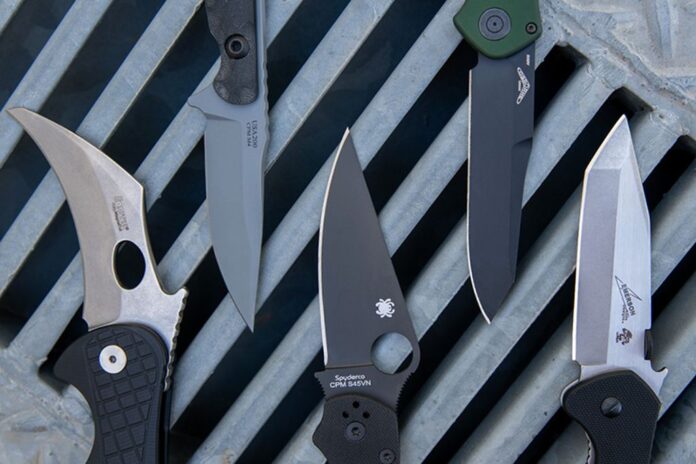I generally prefer folders to straight blades for defensive knives in urban environments – even though straight blades are more reliable. The reason is because it draws less attention from the public and law enforcement.
Over the years I’ve been asked hundreds of questions about knife materials students: including handle materials, locking mechanisms, blade steels and blade points etc.
Handle materials: I’ve noticed that many skilled knife instructors generally lean towards natural materials for small and large knives – I personally prefer them as well. My favorites are antlers and rubber (or some type of rubbery material). I usually avoid some type of micarta and plastic or plastic-like materials, I find that they can sometimes slip out of your hand.
Locking mechanisms: I prefer safe knife locking mechanisms, such as: the back Lock(Lock Back). It’s a spring-loaded bar in the spine of the handle locks into a notch on the blade tang. You press down on the exposed portion of the lock to release it – this is one of the most common and reliable locking systems.
The liner lock is a good choice as long as the metal liner inside is not too thin. The metal liner inside the handle flexes over to lock against the blade tang. To unlock, you push the liner away from the blade with your thumb. It’s simple, strong, and allows for ambidextrous operation. Note: some liner locks are thin and with enough pressure can close on your fingers. The Frame Lock is similar to a liner lock, but uses part of the actual handle frame (usually titanium or steel) instead of a separate liner. This creates a very strong lock since the frame itself is doing the locking.
The Compression Lock is Spyderco’s system where a leaf spring in the handle compresses against the blade tang. You push the lock mechanism forward to release. It’s extremely strong and has a distinctive feel. The Triad Lock by Cold Steel uses a unique combination of features that responds exceptionally to both positive and negative pressures and has been tested to hold up to 800 pounds of hanging weights.
Another great lock comes from Benchmade Knives. It’s called the Axis Lock, it’s a proprietary system using a spring-loaded bar that moves perpendicular to the blade. You pull the bar back with your thumb and finger to unlock. It’s ambidextrous and very secure.
It’s important to stay away from pocketknives and Victorinox type of knives for self-defense. Any folders that don’t lock can easily close on your fingers.
Blade Steels: The most asked questions have always been about blade steels. Some students invest hundreds of dollars in a knife – but unless you are in the military and have a favorite blade you want to use and re-use there is no reason to be overly concerned about the materials. Most quality knife manufacturers produce knives with excellent metals.
The best knife materials depend on the intended use. The “best” depends on intended use – stainless steels dominate the market for convenience, while carbon steels excel in pure cutting performance but require more maintenance. The most common high quality knife blades are S35VN and 154CM.
Regarding blade points, the most popular blade points are drop point and tanto point. However IMO the best general defensive blades are a combination of the two in the Emerson Commander, which has a little more belly to the front of the cutting edge.
Knife Specs: Handles, Locks, Blade Metals and Blade Profiles
Knife Handles / Scales
Most popular knife handle materials and their characteristics:
*Natural Materials
Wood
- Traditional and attractive, with many species available
- Warm feel, good grip when dry, but can be slippery when wet
- Requires more maintenance, can crack or warp overtime
Bone/Antler
- Classic traditional material, often used on pocketknives
- Unique appearance with natural patterns
- Can be brittle and require careful handling
Leather (Stacked)
- Made from layered leather washers compressed together
- Good grip, absorbs shock well
- Can deteriorate with moisture and heavy use
Cork
- Cork is a lightweight material that comes from a tree
- Cork is soft and prone to denting or compression over time
- Cork is not as durable as traditional handle materials
__________________________________________________________
Synthetic Materials
Paracord
Paracord wrapping works well for survival and tactical knives
- It offers an excellent grip, even when wet or bloody
- Can be unwrapped in emergencies for rope/cordage
- Not as precise or refined feeling as solid handles
Micarta
- Layers of fabric or paper soaked in resin and compressed
- Extremely durable, good grip even when wet
- Available in many colors and patterns, popular with custom makers
G-10
- Fiberglass-based laminate material
- Very strong, lightweight, and weather-resistant
- Can be textured for better grip, available in multiple colors
Carbon Fiber
- Lightweight, very strong, and has a distinctive woven appearance
- Expensive but highly durable
- Can be slippery without texturing
__________________________________________________________
Metals
*Aluminum
- Lightweight, corrosion-resistant, and affordable
- Can be anodized in various colors
- Can become slippery and cold in adverse conditions
*Titanium
- Extremely strong, lightweight, and corrosion-resistant
- Expensive but virtually indestructible
- Can be treated for different colors and textures
Stainless Steel
- Durable and easy to clean
- Heavy and can be slippery
- Often used in kitchen knives
Kraton/TPE
- Soft, grippy rubber-like materials
- Excellent grip in wet conditions
- Can degrade over time with UV exposure
Zytel/Nylon
- Tough, lightweight synthetic
- Good for rough use, easy to clean
- Can feel cheap compared to premium materials
Defensive Knives for Urban Environments Part 3 PDF
Defensive-Knives-Part-3Defensive Knives for Urban Environments Part 1
Defensive Knives for Urban Environments Part 2
Defensive Knives for Urban Environments Part 3
Defensive Knives for Urban Environments Part 4


